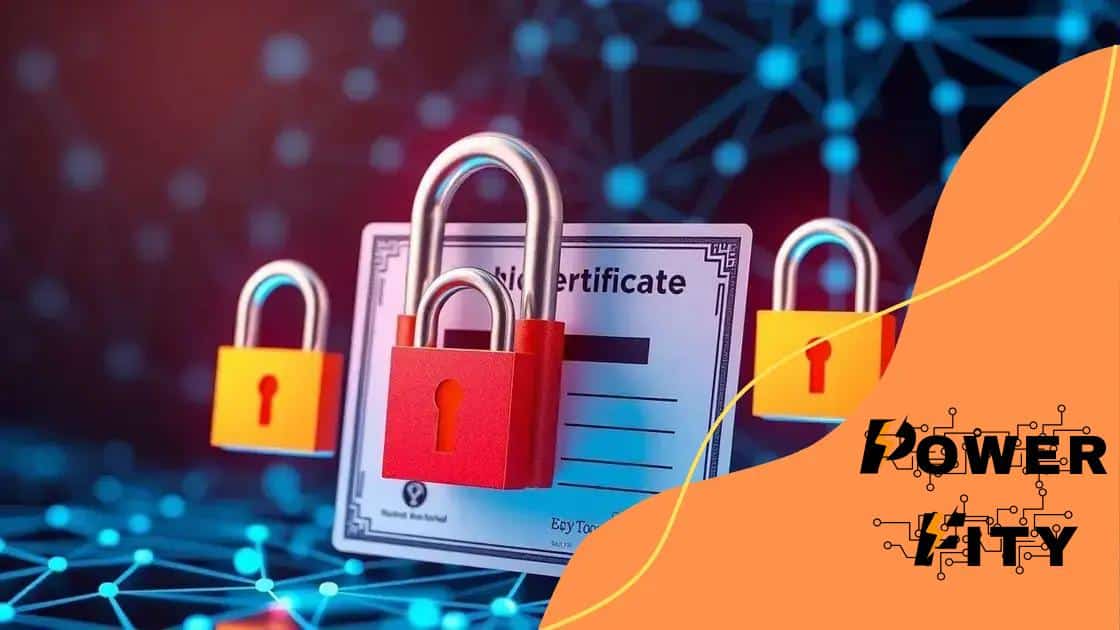Blockchain in education for credential verification

Blockchain in education ensures secure credential verification by providing immutable records, enhancing transparency, and reducing fraud through decentralized verification processes.
Blockchain in education is changing how we verify credentials. Imagine a world where your degrees and certifications are easily and securely verified, eliminating fraud. Let’s dive into how this technology can transform education.
Understanding blockchain technology
Understanding blockchain technology is essential for grasping its impact on various sectors, including education. At its core, blockchain is a decentralized ledger that records transactions across many computers. This technology ensures that records cannot be altered retroactively, providing security and transparency.
By using blockchain, educational institutions can store and verify records like diplomas and transcripts securely. Each transaction creates a block that is linked to the previous one, forming a chain. This makes it nearly impossible for anyone to tamper with information.
Key Characteristics of Blockchain
There are several characteristics that define how blockchain technology operates:
- Decentralization: No central authority controls the data.
- Transparency: All participants can access the same records.
- Immutability: Once recorded, data cannot be changed.
- Security: Each block in the chain is encrypted, adding layers of protection.
These features combine to create a secure and reliable platform for managing education-related credentials. Moreover, blockchain reduces the risk of fraud, which is a significant issue in credential verification.
For example, when students graduate, their accomplishments can be instantly verified from anywhere in the world. This is a game-changer for employers seeking trustworthy information about potential hires. They can confirm degrees without extensive background checks, saving both time and resources.
In addition, students can control their own records, granting access to employers or institutions as needed. This empowerment adds a personal touch to the educational experience. By understanding how blockchain technology operates within education, stakeholders can adopt more secure and efficient verification methods.
Benefits of using blockchain in education
The benefits of using blockchain in education are multifaceted and can greatly enhance how institutions operate. One of the primary advantages is increased security. By using blockchain, educational records are stored in a way that makes them nearly impossible to alter or forge, thus protecting the integrity of degrees and certificates.
Moreover, this technology streamlines the process of credential verification. Traditional methods can be time-consuming, sometimes taking weeks. With blockchain, verification can happen almost instantly, saving valuable time for both students and employers.
Key Advantages
Implementing blockchain in education offers several clear benefits:
- Transparency: All transactions are visible to authorized parties, reducing the risk of fraud.
- Efficiency: Faster processing times for verifying credentials.
- Cost-effectiveness: Reduces the administrative overhead associated with record keeping.
- Accessibility: Students can easily access their records from anywhere in the world.
These attributes make it easier for educational institutions to manage records and maintain trust with students. Additionally, students gain more control over who sees their information and when, which adds another layer of privacy.
Another key benefit is the potential for a global standard. By adopting blockchain technology, educational credentials can be easily recognized across borders. This facilitates student mobility and international job opportunities. For instance, a degree verified through blockchain in one country can be automatically accepted in another, reducing complications for students moving abroad.
As more institutions explore the benefits of using blockchain in education, we can expect to see a transformative shift in the way educational credentials are handled. With improvements in security, speed, and global recognition, blockchain technology is set to change the educational landscape for the better.
How blockchain enhances credential security

Blockchain technology significantly enhances credential security in various essential ways. The foundation of this technology is its decentralized nature. Instead of being stored in a single location, blockchain records are distributed across numerous computers. This means that no single point is vulnerable to attacks or manipulations, making it much safer.
Each credential is saved in a block, and once a block is added to the blockchain, it cannot be changed or deleted. This immutability is a critical feature, as it assures everyone that the information has not been tampered with. By ensuring that records remain unchanged, blockchain creates trust between educational institutions and employers.
Key Features of Blockchain for Credential Security
Several features make blockchain a powerful tool for enhancing security:
- Encryption: Data is secured by cryptographic methods, making it difficult for unauthorized parties to access it.
- Auditability: Every transaction is recorded in a transparent manner, allowing authorized users to track changes.
- Decentralized verification: Records can be verified by multiple parties, ensuring that no single entity can influence the system.
- Instant updates: Any changes to the records are updated in real-time, providing immediate access to the latest verified information.
With these features, educational institutions can confidently issue digital diplomas and certificates, knowing they hold a reliable way to verify authenticity. This added layer of security significantly reduces the risks of fraud, which has been a prevalent issue in credential verification.
Employers benefit from this as well. Hiring managers can quickly and easily confirm the educational backgrounds of candidates without extensive delays. When a candidate provides a blockchain-verified credential, employers can trust its accuracy without additional verification processes.
Furthermore, with the ever-increasing number of online courses and degrees, credential security becomes even more critical. As education evolves, using blockchain ensures that all parties involved can maintain a high level of integrity and confidence in the credentials they rely on.
Real-world examples of blockchain in use
There are numerous real-world examples of blockchain in use across various sectors, and education is no exception. One prominent case is the use of blockchain technology for issuing diplomas and certificates securely. Institutions like MIT and the University of Nicosia have already begun providing verified digital diplomas on the blockchain, ensuring that graduates can easily share their credentials with employers or other educational institutions.
This innovative approach not only protects against fraud but also simplifies the process for both students and administrators. Imagine a recent graduate applying for a job and simply sharing a link to their verified diploma. This significantly reduces the lengthy background check processes that often plague job applicants.
Notable Implementations
Several organizations are leveraging blockchain in education:
- Open University: They utilize blockchain for credential verification, allowing students to retain control over their educational records.
- Smart Degree: This platform offers blockchain-based diploma verification, facilitating a straightforward process for employers to authenticate credentials.
- Blockcerts: A standard for creating, issuing, viewing, and verifying blockchain-based certificates. Institutions can integrate Blockcerts to streamline their credentialing process.
- APPII: A service that enables individuals to store their qualifications and share them securely through blockchain technology.
More than just a trend, these real-world examples of blockchain in use showcase the technology’s potential to revolutionize the educational landscape. As blockchain is increasingly adopted, it also opens new possibilities for collaboration among institutions worldwide.
Furthermore, this technology can enhance student mobility through verified records that can be recognized across borders. A student from India can study in the U.S. and have their qualifications seamlessly verified back home, easing the transition into the global workforce.
By observing how these institutions integrate blockchain, we can see a glimpse of the future of education. Improved security, authenticity, and speed in credential verification help create a more reliable system that benefits both students and employers.
Challenges in implementing blockchain for verification
Implementing blockchain for verification in education comes with its unique set of challenges. While the benefits are promising, institutions must navigate several obstacles to effectively adopt this technology. One significant challenge is the initial cost of implementation. Many educational institutions may struggle with the financial investment required to establish a blockchain infrastructure, including the necessary software and training.
Another challenge arises with the regulatory landscape. Various countries have different regulations regarding data privacy and security. Educational institutions need to ensure that they comply with these rules while using blockchain technology. This can complicate the integration process, as laws may vary widely across jurisdictions.
Technical Limitations
Technical limitations also pose barriers to effective blockchain implementation. These include:
- Scalability: As more users engage with the blockchain, performance can degrade, leading to slower transaction times.
- Interoperability: Many different blockchain systems exist, and they may not communicate with each other effectively.
- Data Storage: Storing large amounts of data on the blockchain can be expensive and inefficient. Institutions must find solutions to manage data effectively.
- Technological Expertise: There is a shortage of professionals who understand blockchain technology, making it difficult for institutions to hire the right talent for implementation.
Furthermore, gaining acceptance and trust from stakeholders can be a hurdle. Educators and students may be skeptical about switching from traditional systems to blockchain. Overcoming this resistance requires education about the benefits of blockchain and demonstrating its reliability.
Despite these challenges, many institutions are beginning to recognize the long-term benefits of blockchain technology. As the technology evolves, it is likely that solutions to these challenges will emerge, making it easier for organizations to implement blockchain for verification effectively.
FAQ – Frequently Asked Questions about Blockchain in Education
What is blockchain technology?
Blockchain technology is a decentralized digital ledger that records transactions across many computers securely, ensuring that the records cannot be altered.
How does blockchain enhance credential security?
Blockchain enhances credential security by providing immutable records, encryption, and decentralized verification, making it difficult to forge or alter credentials.
What are the benefits of using blockchain for credential verification?
The benefits include increased security, efficiency in verification processes, and worldwide recognition of credentials, streamlining education and employment.
What challenges exist when implementing blockchain in education?
Challenges include high implementation costs, regulatory compliance, technical limitations, and gaining acceptance from stakeholders.





